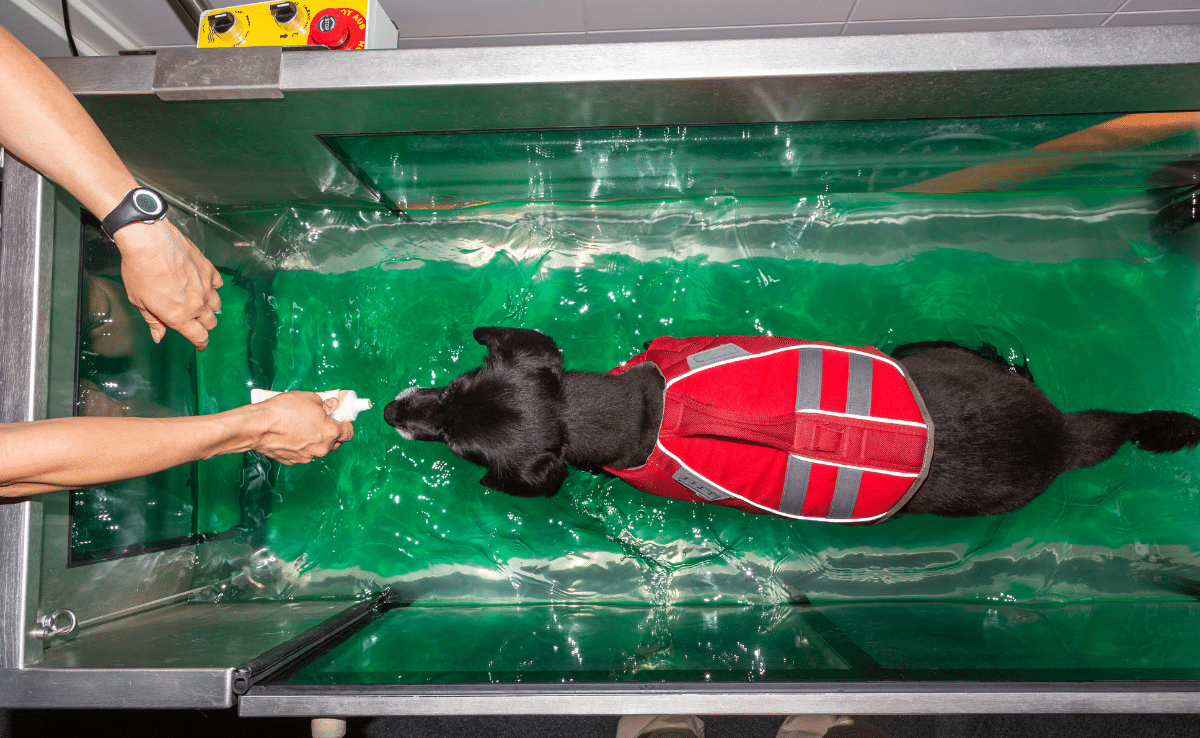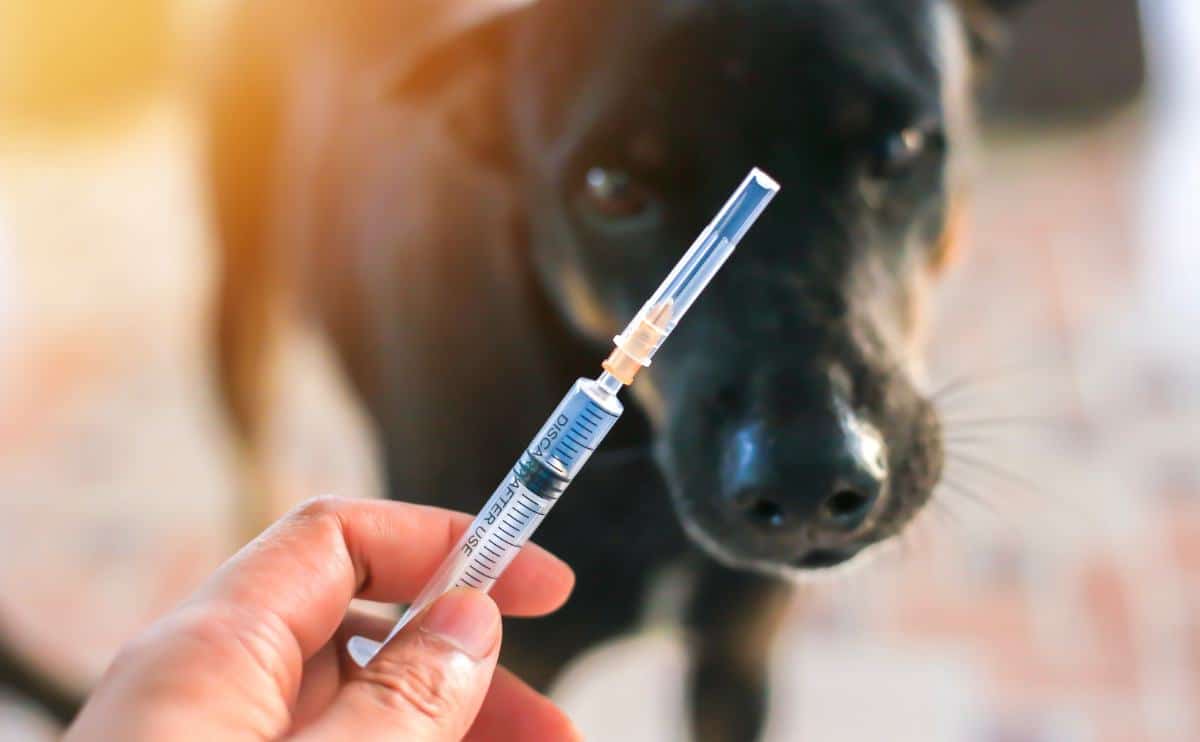Hydrotherapy For Dogs: What Is It & How Can It Help Your Pet?
When you purchase through links on our site, we may earn a commission. Here’s how it works.

Hydrotherapy, or aquatic therapy, is a very old practice. Humans have been using warm water for bathing, exercise, and healing for thousands of years to relieve pain and improve wellbeing. This being said, we have only started using it regularly in veterinary treatment for small animals over the last 20 years or so. So, what is dog hydrotherapy, and what are its benefits?
Table of Contents
What Is Hydrotherapy?
Simply put, hydrotherapy is taking advantage of the physical properties of water to facilitate exercise, pain relief, and healing. There are many ways water can be used to relieve pain, build strength and promote healing, especially when a patient is unable to, or will find it too challenging, to exercise on dry land.
The benefits of hydrotherapy in dogs may not be as well documented in the scientific literature when compared to people, but the fact that many pet insurance companies are now willing to cover its cost, at least partially, speaks volumes. Indeed, hydrotherapy will often mean healing will be faster and health generally improved, which makes it a great addition to many treatments.
What Is Hydrotherapy For Dogs Used For?
The main goals of hydrotherapy in dogs are to improve strength, coordination, and mobility, to decrease pain, and to improve the overall quality and duration of life.
Dogs who might particularly benefit from water therapy are patients with:
- Orthopedic issues (before or after surgery)
- Certain neurological and balance problems
- Conditions that make them more prone to losing muscle mass
- Sore joints and muscle wasting (in senior dogs)
- Obesity and who otherwise struggle to exercise and lose weight
- Painful joints from osteoarthritis or at higher risk of joint disease, like hip dysplasia
In addition, sporting dogs can benefit from it, and the extra physical conditioning hydrotherapy provides. Similar to athletes who condition their muscles to be extra strong.
How & Why Does Water Therapy Work?
Hydrotherapy has been widely recognized to help with multiple musculoskeletal and neurological conditions in people and animals alike. This is because of the unique physical properties of water, but also because of how the body usually goes about healing. Let’s dive into this a bit deeper.
Temperature
Hydrotherapy water is usually between 83-90°F, so it often feels pleasantly warm. Some of the benefits of this are the relief of muscle spasms, decreased pain, improved circulation (which in turn promotes healing), and general relaxation of the patient.
Hydrostatic Pressure
This is the direct compressive force water exerts on a submerged object. This naturally helps by decreasing limb swelling through gentle compression, as well as improving circulation.
Density & Buoyancy
Water is denser than fat but less dense than bone. This means certain dogs have bodies that are more likely to sink and others that are more likely to float, but either way, water will help carry some of the weight, though some dogs might need the extra help of buoyancy devices. In many cases, the goal of hydrotherapy in dogs is to find the sweet spot where the correct ratio of the dog’s body is supported by the water, significantly decreasing pressure on the joints and making it easier to exercise.
Viscosity & Resistance
Water is about 15 times more resistant to movement than air. This means moving underwater has several direct benefits:
- Helps build strength and muscle mass more quickly
- Improves endurance and fitness because of the increased effort
- Slows down falls and compensates for the loss of balance, allowing for even wobbly neurological patients to have enough time to readjust their position
Surface Tension
The molecules at the surface of water stick more tightly together than deeper under the surface, which means that breaking through the surface of the water (paw out then back in) requires more effort than simply moving the paw underwater. This is another helpful property of water when it comes to tailoring exercises to specific strengthening goals.
Flexibility
As you may have noticed, another interesting aspect of hydrotherapy for dogs is how easy it is to tweak the factors above. For example, the therapist can adjust the water’s depth and the treadmill’s speed or add more resistance by creating turbulence through pressure jets. It is, therefore, easy to increase or decrease weight support, the structure and difficulty of the exercises, and help a dog gently learn a new movement without too steep of a learning curve.
What Kinds Of Water Therapy Modalities Exist For Dogs?
There are two primary modalities physiotherapists tend to use for hydrotherapy in dogs, and these are pools and treadmills. Both have beneficial properties.
Pools
Benefits of swim therapy:
- Completely non-weight bearing
- Very low impact
- An excellent upper body and cardiovascular workout
- Improves active range of motion of all joints at once
- Helps increase core and trunk strength
- Builds endurance and lean muscle mass
Underwater Treadmills (UWTM)
UWTM strengths:
- Allows for adjustable and tailored weight-bearing as well as speed
- Can start early after surgery or trauma
- Improves active range of motion
- Helps with neurological therapy by improving awareness of the body in space (proprioception) and balance
- Builds endurance and lean muscle
- A good starting point for learning how to swim
You can learn more information on treadmills and underwater dog treadmills. We also have information on indoor dog treadmills.
What About Hydrotherapy For Dogs At Home?
Many owners know the benefits of recreational swimming for their dogs, either in a pool at home or out and about. This can be fantastic exercise to keep dogs fit, not to mention a lot of fun. This being said, if hydrotherapy is being considered for a specific health reason, if the dog has any medical condition at all, is older, or is not an experienced swimmer, it is best to proceed under the guidance of professionals. After all, water exercise is great but not entirely safe without precautions, and just like people, some dogs are natural water lovers and swimmers, and some are not.
As simple as hydrotherapy for dogs might sound, there is actually a careful art and science to it in how sessions and exercises are designed, how much water is used, and how buoyancy devices are used. It is best to get started with some help when in doubt.
This being said, if an owner gets the all-clear and the necessary guidance to conduct dog water therapy at home, there can be a few solutions, such as a horse trough, a child’s swimming pool, or even the bathtub lined with a non-slipping mat, for smaller dogs.
FAQ About Water Therapy For Dogs
Below are some frequently asked questions regarding water therapy for dogs.
Is swimming good for dogs with arthritis?
Swim therapy is generally very beneficial for dogs with arthritis as it helps bulk muscle mass, relieving pressure on the joints. Many of these dogs cannot do this on solid ground as it is too painful, creating a vicious cycle. Hydrotherapy can help break the cycle and keep these dogs stronger, in less pain, and with a much better quality of life.
What about hydrotherapy for dogs with hip dysplasia?
As always, this will depend on the patient, but hydrotherapy is usually thought to be very beneficial for dogs with hip dysplasia as it helps strengthen the muscles around the hip and put less pressure on the joint. Especially if hip dysplasia is present but not causing symptoms yet, hydrotherapy can be part of how damage to the joint is prevented.
How much is hydrotherapy for dogs?
The cost of water therapy for dogs varies depending on several variables, for example, the general geographical location, the specific center chosen, the type and length of hydrotherapy sessions, or the condition being treated, to name a few. As a loose ballpark, fees often seem to land between $30-50 per 30-minute session, depending on whether a pool or a treadmill is used.
Whether hydrotherapy is covered or not is worth bearing in mind when an owner is shopping for health insurance for their dog, especially for active and larger breeds, as this can significantly help reduce out-of-pocket expenses.
Other Ways To Help Dogs With Joint Pain
Hydrotherapy is an ancient and well-documented mode of therapy in people and has been gaining in popularity over the last 20 years in animals. The multiple beneficial properties of warm water mean that it is now often prescribed by vets to help manage various health conditions and is often part of a multi-pronged approach when it comes to the rehabilitation and improvement of the quality of life of our furry friends.
While in most cases, it is best for hydrotherapy in dogs to be performed and overseen by a specialized physiotherapist, there are cases where, with proper caution and guidance, some dogs might benefit from sessions at home as well. Learn about other types of therapy for dogs and more ways to help alleviate arthritis and orthopedic pain in your dog, including laser therapy, orthopedic dog beds, and possibly even a dog wheelchair.



